
It was about 10 years ago and just another day in Anatomy class. We were still trying to wake up, talking about how inhumane it is to have 8 o clock classes on Monday mornings. Our 70 year old professor enters the class, looking more bored than ever. Today’s topic: The Cranial Nerves. A confusing topic of 12 different nerves starting from lower part of the brain, each one with a different function. About two long hours later and it was time to talk about the 10th cranial nerve, the Vagus. So many functions, way too many branches. But there was a small branch of this nerve that grabbed my attention as soon as our professor started to carefully dissect it in the formaldehyde covered human body we had available for our class. There was something strange about this nerve, something that didn’t make sense. Its name was the Recurrent Laryngeal Nerve (RLN) and it was through trying to learn more and make sense out of it that I discovered probably one of the most fascinating parts of the human body, one that may hold the evidence to the common ancestry of species and evolution.
A brief, but important, Anatomy lesson
The human body has two RLNs, one on the left and one of the right side. Both are branches of the left and right Vagus nerves respectively. The right RLN is approximately 6cm long and it branches off the right Vagus nerve at the level of the right Subclavian artery, not far above from the right side of your upper sternum. It forms a loop under the Subclavian artery and goes up to your Larynx (the ‘voice box’). The left RLN has double the length and it reaches approximately 12cm (remember this difference). It branches off the left Vagus nerve a few centimeters lower compared to the right one. It passes under the Aortic arch (the curved part of the Aorta after it exits the heart) and then, just like the right RLN it goes up to the Larynx. Now the word ‘Recurrent’ should start making more sense. It is called this way as it moves to the opposite direction (upwards) compared to the initial direction (downwards) of its origin, the Vagus nerve.
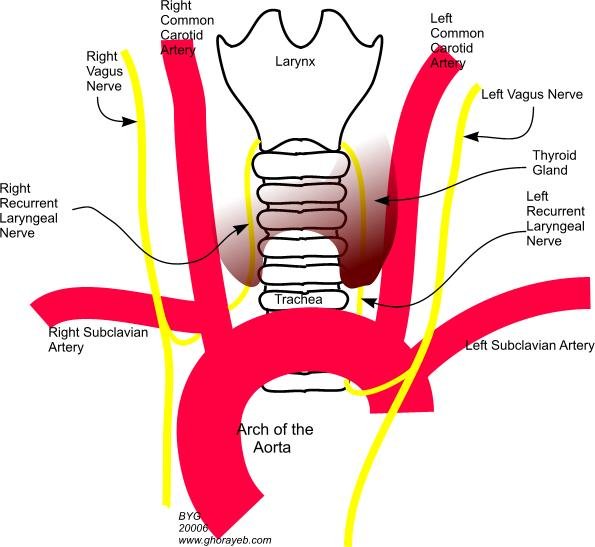
The right and left RLNs (in yellow) and their surrounding structures
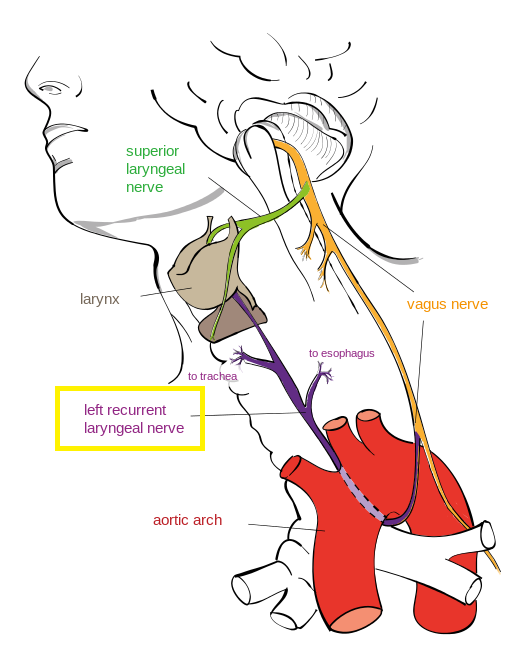
A closer look at the left RLN and its unusual route
The function of these nerves is the same in humans and other mammals. By innervating the intrinsic muscles of the larynx they allow animals to control their vocal cords and therefore make sounds. These nerves are absolutely vital for communication, mating calls, warning against potential danger and also for transmitting sensory information to the brain. The correct function of these nerves offers a huge survival advantage to all animals. Our vertebrate friends living in the sea also have analogous nerves and it is by studying their anatomy (and our embryology) that we start to realise a close link between us and how evolution can be used to explain both our similarities but also our differences.

A mythical creature: half human, half fish.
A story of fish, arteries and bad engineering
I want you to imagine that you are the CEO of a large European Railway Company. You plan to build a huge underground tunnel connecting Frankfurt and Paris. You ask from (what seems to be) a very highly qualified engineer to design it. You expect that he will come back with a direct, safe and cost-efficient tunnel following the shortest route possible. Instead he comes back with a tunnel which goes south towards Stuttgart, passes through Austria, then underneath the snowy Italian Alps, makes a U-turn around Milan, under the Alps again, has a quick pass through Switzerland to finally reach its destination in Paris.
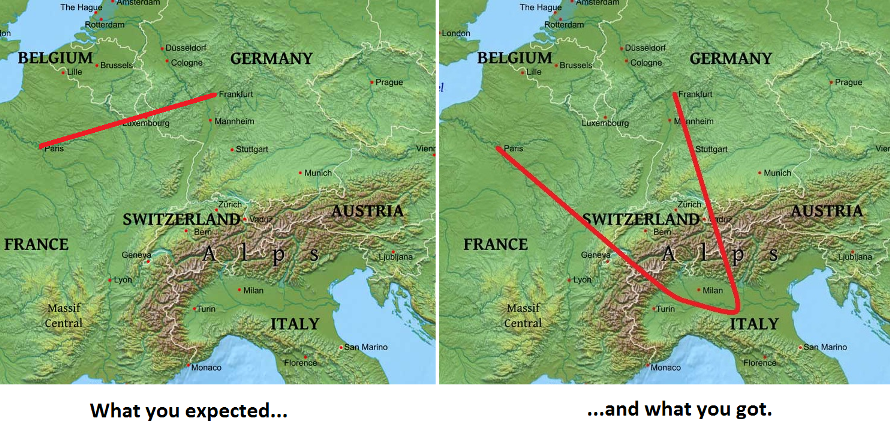
What would you think about his plan? Would you consider it as an ‘Intelligent Design’? I will guess that the answer is No. You would probably throw away his plan in the trash, even start to question whether he is a true engineer. Now go back to the anatomy part of this article and take a look at the picture of the RLNs, especially the left one. Why would a nerve which has to go from the brain to the larynx, ends up moving away from its destination and forms loops inside our upper chest just to turn back? What kind of engineer or ‘Creator’ would ever take such a nonsense decision? A decision that not only is inefficient but it also exposes the left RLN to diseases such as vascular insults, infections, tumors, medical injuries during surgeries and trauma. If this route seems strange to you, try to imagine how unreasonable and illogical it is in giraffes. Yes, that’s right! The RLN follows the same route in giraffes only this case, it isn’t just 12cm long. It travels through a 6ft long neck (almost 2 meters) just to make the same loop back inside the neck and reach its destination in the giraffe’s vocal apparatus, adding up to a total of up to 15ft (almost 5 meters) in length. If you don’t believe me, check this giraffe dissection video:
***WARNING – GRAPHIC VIDEO***
Evolution doesn’t always care about efficiency and short distances. Its natural selection doesn’t choose the most elegantly ‘designed’ animal, but it gives priority to the one which is most capable of survival and reproduction. But how can the route of the RLN make sense? To understand that, we have to go back to the embryology of humans and the anatomy of our ancestors: the sea creatures. Around the 4th week of development, structures known as ‘Pharyngeal Arches’ appear in the human embryo. The same arches are also found in all vertebrates. In fish, these arches form the Branchial arches and function as support for the gills. Pharyngeal arches are numbered 1,2,3,4 and 6. Each arch gives rise to different structures of the human body: bones, muscles, arteries and nerves. The RLNs are formed from the 6th arch.
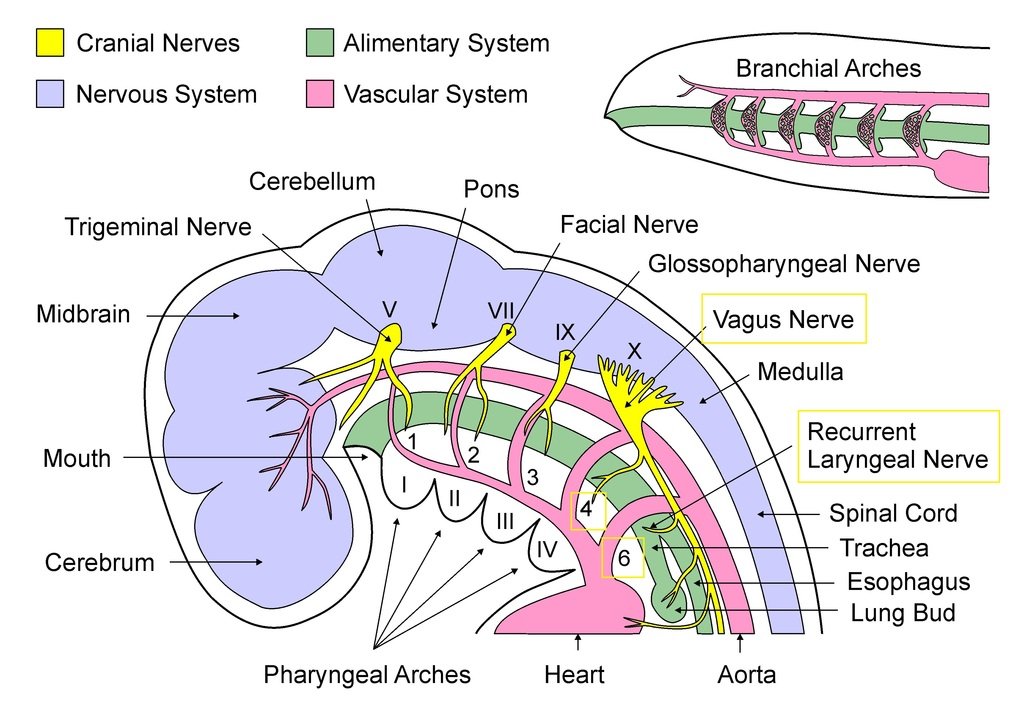 You can see the RLN just under the arteries of the 6th arch
You can see the RLN just under the arteries of the 6th arch
The analogous nerve in fish (the 4th branch of the Vagus – just like in humans) is also formed from the 6th branchial arch. The same arch (together with the 4th arch) gives rise to various important arteries in both fish and humans. The RLN exits the Vagus just below these arteries. Here comes the big difference. In fish both the arteries and the nerve follow a very similar and straight route, from the brain of the fish to the gills. Humans though ‘got rid’ of the gills and have developed a structure that fish don’t have: the neck. As the neck developed the RLN remained ‘trapped’ underneath the major vessels of the 4th and 6th arches, which were now 'migrating' to our chest cavity. The length and position of the neck were changing but it was impossible to change the whole human embryological development, just to provide a shorter route for the RLN. In other words the RLN had to follow the changing position of the arterial component of the arches. This is how it developed this extraordinary and unusual route.
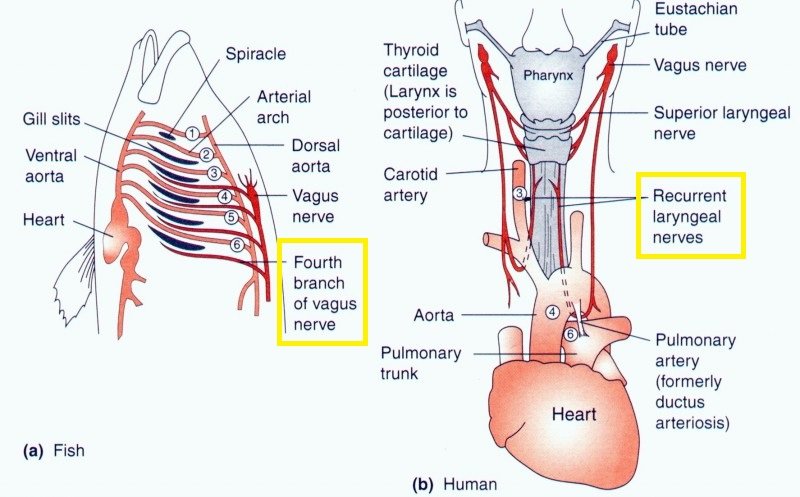 You can see the direct route the 4th branch (equivalent of RLN) of the Vagus nerve follows in fish, together with the artery. Compare that with the corresponding structures in Humans. The 'trapped' RLNs had to follow a much longer route now to perform their function.
You can see the direct route the 4th branch (equivalent of RLN) of the Vagus nerve follows in fish, together with the artery. Compare that with the corresponding structures in Humans. The 'trapped' RLNs had to follow a much longer route now to perform their function.
Many examples of common ancestry evidence can be found throughout the vertebrate anatomy. The further back someone goes to our embryological development, the more similarities he can discover. But the RLN is my favourite example to use in order to debunk the myth of ‘intelligent design’ and support the truth of Evolution, an ‘unintelligent’ but still even more amazing and logical answer to the mystery of the origin of life.
Thank you for reading, let me know if you would like me to expand more on certain topics.
CT.


